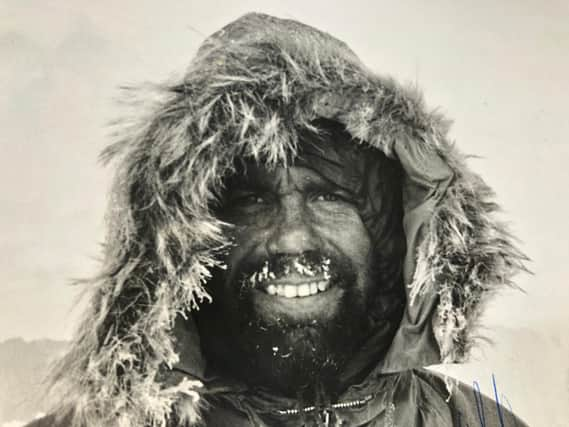Obituary: Hugh Simpson, explorer and pioneer of breast cancer research


Professor Hugh Simpson was an explorer, mountaineer, accomplished skier, photographer, pioneer of breast cancer research and renowned global lecturer. In Hugh’s family there was a tradition of medicine; his mother was one of the first women doctors and Hugh’s great grand uncle was Sir James Young Simpson, the renowned obstetrician, so Hugh never really had a choice other than to be a doctor.
He was Professor of Pathology at the University of Glasgow and visiting scientist at various global institutions including The National Institutes of Health, Washington DC, University of Minnesota, and Chengdu University, China.
Advertisement
Hide AdAdvertisement
Hide AdHugh was a son of the manse in Ceres, Fife, where his father, Ian, was a well-known Church of Scotland minister, published philosopher and war pilot and mother, Nora, a doctor of child public health. He went to Bryanston School and then studied medicine at the University of Edinburgh.
Much of his early adulthood was spent climbing in the Scottish Highlands and sometimes in the Alps. Hugh had the record for climbing the nine highest Cairngorms in 24 hours as well as all UK mountains over 4,000ft in 48 hours.
On graduation in 1955 he secured the role as Medical Officer for the Falkand Islands Dependency Survey and spent four years in the Antarctic. Much of the time was for exploring and mapping with close friends Wally Herbert and Roger Tuft. More than 4,000 miles were dog-sledged, and a mountain is named after him (Simpson Nunatak, 3,822ft, Trinity Peninsula). His science was important to him and during these lengthy sledging trips for months on end, through blizzards and -70 degree Celsius temperatures, he trailblazed medical data collection and analysis, all the time researching stress in an arduous climate.
On his way back from the Antarctic he joined the Edinburgh Andean Expedition with Billy Wallace and a certain Myrtle Emslie. They camped with Peruvian Indian shepherds, travelled by donkey in the Cordillera Blanca and made first ascents of seven virgin peaks, two of which were over 20,000ft. They even forged a new route on Peru’s highest mountain, the Huascaran.
Perhaps due to the adverse effects of high altitude Hugh subsequently became engaged to Myrtle and a lifelong marriage of more than 60 years ensued. Adventure was always part of the couple’s DNA and Hugh was awarded the Polar, the Pery and the Mungo Park Medals.
Explorations and academic achievement were the name of his game, always with the touch of the unorthodox. Hugh was a Professor of Pathology at Glasgow Royal Infirmary for four decades. He authored 164 academic papers and, most importantly, he is remembered by thousands of medical students for his “engaging” teaching. He was a Gold Medal Lecturer for the Royal College of Surgeons (Edinburgh), he gave the Scientist of the Year Lecture (Little Rock, Arkansas, USA), and he was founder editor of the International Journal of Chronobiology. He was on Hillary Clinton’s panel for breast cancer research and his patented invention, the Chronobra, which targeted early cancer risk detection, paved the way for a whole new scientific approach.
His science drove his exploration and vice versa. In 1960, when his first son, Robin, was just four months old he led a medical research expedition to Spitsbergen and the family went too. They lived on a 21-hour day and eight-day week and the midnight sun provided Hugh with a perfect laboratory for studying circadian rhythms (this was funded by NASA). The family paused en route to visit the Lapps for some tips on how to look after a baby in Arctic climes and this set a trend for the future.
Hugh and Myrtle would cross Greenland on skis in 1965, and in 1969, in an attempt to be the first to reach the North Pole, they would set the record for the farthest North reached by any unsupported expedition.
Advertisement
Hide AdAdvertisement
Hide AdAs their family grew to four children (Robin, Bruce, Rona, Rory), most summers saw the Simpsons living with indigenous peoples (from Greenlanders, to Canadian First Nations, and the Wayana Indians in the Suriname rainforest), while living “off the land” for months. Hugh would carry out medical research, Myrtle would write stories of the journeys (publishing 12 books) and the ever-growing family would thrive. Hugh was Man of the Year for Greenland Radio and the 1974 BBC production, The Land Where the Glaciers Grow, was a movie of one of the family journeys.
Hugh would continue to hill walk, camp, fish, canoe and even ski race for the rest of his life and his final arctic adventure was in 2011. In 2002 he moved permanently to Farletter, in the Cairngorms, where he and Myrtle provided a welcoming hub of activity for the extended family, who now lived all over the world. He created a unique environment of learning and outdoor experience which was enjoyed by four generations of family and innumerable friends.
Hugh was generous and he was a listener. He was erudite and he was kind – always deeply engaged and interested in whomever he was talking to, from whatever background, on any topic.
Hugh Simpson died peacefully in the excellent care of The Mains, Newtonmore. He leaves behind his wife Myrtle, his big sister Faith, four children, ten grandchildren and four great-grandchildren.
RORY SIMPSON
Obituaries
If you wish to submit an obituary, contact [email protected]
A message from the Editor
Thank you for reading this article. We're more reliant on your support than ever as the shift in consumer habits brought about by coronavirus impacts our advertisers.
If you haven't already, please consider supporting our trusted, fact-checked journalism by taking out a digital subscription.